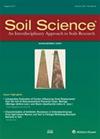Delineating the distribution of mineral and peat soils at the landscape scale in northern boreal regions
4区 农林科学
Q2 Agricultural and Biological Sciences
引用次数: 6
Abstract
Abstract. To meet the sustainable development goals and enable sustainable management and protection of peatlands, there is a strong need for improving the mapping of peatlands. Here we present a novel approach to identify peat soils based on a high-resolution digital soil moisture map that was produced by combining airborne laser scanning-derived terrain indices and machine learning to model soil moisture at 2 m spatial resolution across the Swedish landscape. As soil moisture is a key factor in peat formation, we fitted an empirical relationship between the thickness of the organic layer (measured at 5479 soil plots across the country) and the continuous SLU (Swedish University of Agricultural Science) soil moisture map (R2= 0.66, p < 0.001). We generated categorical maps of peat occurrence using three different definitions of peat (30, 40, and 50 cm thickness of the organic layer) and a continuous map of organic layer thickness. The predicted peat maps had a higher overall quality (MCC = 0.69–0.73) compared to traditional Quaternary deposits maps (MCC = 0.65) and topographical maps (MCC = 0.61) and captured the peatlands with a recall of ca. 80 % compared to 50 %–70 % on the traditional maps. The predicted peat maps identified more peatland area than previous maps, and the areal coverage estimates fell within the same order as upscaling estimates from national field surveys. Our method was able to identify smaller peatlands resulting in more accurate maps of peat soils, which was not restricted to only large peatlands that can be visually detected from aerial imagery – the historical approach of mapping. We also provided a continuous map of the organic layer, which ranged 6–88 cm organic layer thickness, with an R2 of 0.67 and RMSE (root mean square error) of 19 cm. The continuous map exhibits a smooth transition of organic layers from mineral soil to peat soils and likely provides a more natural representation of the distribution of soils. The continuous map also provides an intuitive uncertainty estimate in the delineation of peat soils, critically useful for sustainable spatial planning, e.g., greenhouse gas or biodiversity inventories and landscape ecological research.北方寒带地区矿质土和泥炭土在景观尺度上的分布
摘要为了实现可持续发展目标,实现泥炭地的可持续管理和保护,迫切需要改进泥炭地的测绘工作。在这里,我们提出了一种基于高分辨率数字土壤湿度图来识别泥炭土的新方法,该地图是通过结合机载激光扫描导出的地形指数和机器学习来模拟瑞典景观中2米空间分辨率的土壤湿度而产生的。由于土壤湿度是泥炭形成的关键因素,我们拟合了有机层厚度(在全国5479个土壤样地测量)与连续SLU(瑞典农业科学大学)土壤湿度图之间的经验关系(R2= 0.66, p < 0.001)。我们使用三种不同的泥炭定义(有机层厚度30,40和50厘米)和有机层厚度的连续图生成了泥炭发生的分类图。与传统的第四纪沉积图(MCC = 0.65)和地形图(MCC = 0.61)相比,预测泥炭地图的总体质量(MCC = 0.69-0.73)更高,泥炭地的召回率约为80%,而传统地图的召回率为50% - 70%。预测的泥炭地图比以前的地图确定了更多的泥炭地面积,并且面积覆盖估计值与国家实地调查的估计值处于同一顺序。我们的方法能够识别较小的泥炭地,从而绘制出更准确的泥炭土地图,而不仅仅局限于可以从材料图像中视觉检测到的大型泥炭地——这是制图的历史方法。我们还提供了有机层的连续图,有机层厚度范围为6-88 cm, R2为0.67,均方根误差(RMSE)为19 cm。连续图显示了有机层从矿物土到泥炭土的平滑过渡,可能提供了土壤分布的更自然的表示。连续地图还为泥炭土的描绘提供了直观的不确定性估计,这对可持续空间规划至关重要,例如温室气体或生物多样性清单和景观生态学研究。
本文章由计算机程序翻译,如有差异,请以英文原文为准。
求助全文
约1分钟内获得全文
求助全文
来源期刊

Soil Science
农林科学-土壤科学
CiteScore
2.70
自引率
0.00%
发文量
0
审稿时长
4.4 months
期刊介绍:
Cessation.Soil Science satisfies the professional needs of all scientists and laboratory personnel involved in soil and plant research by publishing primary research reports and critical reviews of basic and applied soil science, especially as it relates to soil and plant studies and general environmental soil science.
Each month, Soil Science presents authoritative research articles from an impressive array of discipline: soil chemistry and biochemistry, physics, fertility and nutrition, soil genesis and morphology, soil microbiology and mineralogy. Of immediate relevance to soil scientists-both industrial and academic-this unique publication also has long-range value for agronomists and environmental scientists.
 求助内容:
求助内容: 应助结果提醒方式:
应助结果提醒方式:


